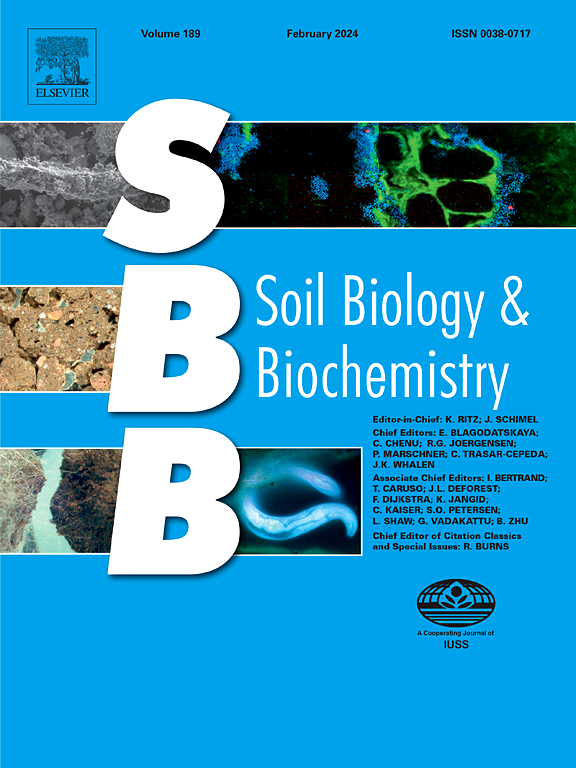Recoupling C and N cycles: a fertiliser template to synchronise N supply and limit C priming?
IF 10.3
1区 农林科学
Q1 SOIL SCIENCE
引用次数: 0
Abstract
Despite their advantages in plant productivity, plant uptake from conventional nitrogen (N) fertilisers is around 50 %. To test whether recoupling carbon (C) and N cycles can decrease losses and increase N use efficiency (NUE), four experiments were conducted. Two growth accelerator pot experiments in contrasting soils were conducted with N additions representing a range of molar C to N ratios (Cmol:Nmol; 0.5 to 11) formulated from urea (U) and waste-derived materials (sugarcane trash, Ct; pelletised beef manure, B; dairy digestate, D; insect larvae, L; protein meal from insect larvae, P; and anaerobic pond sludge, S) with and without a nitrification inhibitor (I). Two reaction vessel experiments were conducted for measuring N-transformation based on continuous on-line nitrous oxide (N2O) and carbon dioxide (CO2) monitoring, and soil analyses. Adverse impacts of these stoichiometric formulations on C priming were examined using natural abundance isotopic signatures. Relative to urea, higher N use efficiency (∼2–3 times) was achieved with waste derived (i.e., D, S, B, and P) formulations with I, with and without C. Increased Cmol:Nmol ratio increased post-experiment N retention in the fertiliser layer and delayed N uptake by the plant. Carbon priming losses were least with formulation Cmol:Nmol from 3.1 to 6.2. Our results suggest waste-derived stoichiometrically tailored formulations with an inhibitor have potential to avoid soil C priming, deliver better NUE, decrease N leaching losses, and increase N stocks in the soil profile.
碳氮循环耦合:同步氮供应和限制碳启动的肥料模板?
尽管它们在植物生产力方面具有优势,但传统氮肥的植物吸收率约为50%。为了验证碳(C)和氮(N)循环耦合是否能减少碳(C)和氮(N)的损失并提高氮素利用效率(NUE),进行了四个试验。在对照土壤中进行了两个生长促进剂盆栽试验,添加N代表摩尔C与N比(Cmol:Nmol;0.5至11)由尿素(U)和废物衍生材料(甘蔗垃圾,Ct;牛粪颗粒,B;乳制品消化,D;昆虫幼虫,L;昆虫幼虫蛋白粉,P;厌氧池塘污泥(S),含和不含硝化抑制剂(I)。在连续在线监测氧化亚氮(N2O)和二氧化碳(CO2)以及土壤分析的基础上,进行了两个反应容器实验,以测量氮的转化。利用天然丰度同位素特征,研究了这些化学计量公式对碳启动的不利影响。与尿素相比,含I、含和不含c的废物衍生(即D、S、B和P)配方的氮素利用效率更高(约2至3倍)。Cmol:Nmol比增加,肥层中实验后氮潴留增加,植物对氮的吸收延迟。Cmol:Nmol为3.1 ~ 6.2时,碳引发损失最小。我们的研究结果表明,含有抑制剂的废物衍生化学计量定制配方有可能避免土壤C引发,提供更好的氮素利用效率,减少N淋失,增加土壤剖面中的N储量。
本文章由计算机程序翻译,如有差异,请以英文原文为准。
求助全文
约1分钟内获得全文
求助全文
来源期刊

Soil Biology & Biochemistry
农林科学-土壤科学
CiteScore
16.90
自引率
9.30%
发文量
312
审稿时长
49 days
期刊介绍:
Soil Biology & Biochemistry publishes original research articles of international significance focusing on biological processes in soil and their applications to soil and environmental quality. Major topics include the ecology and biochemical processes of soil organisms, their effects on the environment, and interactions with plants. The journal also welcomes state-of-the-art reviews and discussions on contemporary research in soil biology and biochemistry.
 求助内容:
求助内容: 应助结果提醒方式:
应助结果提醒方式:


